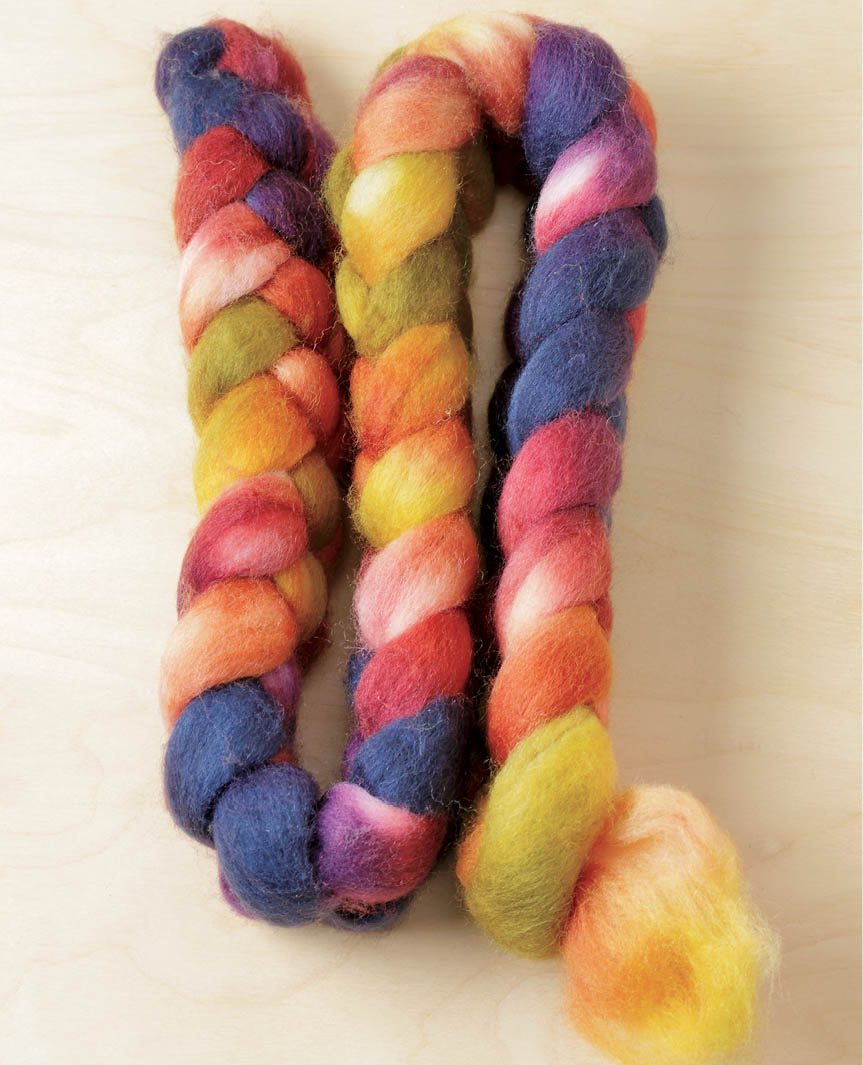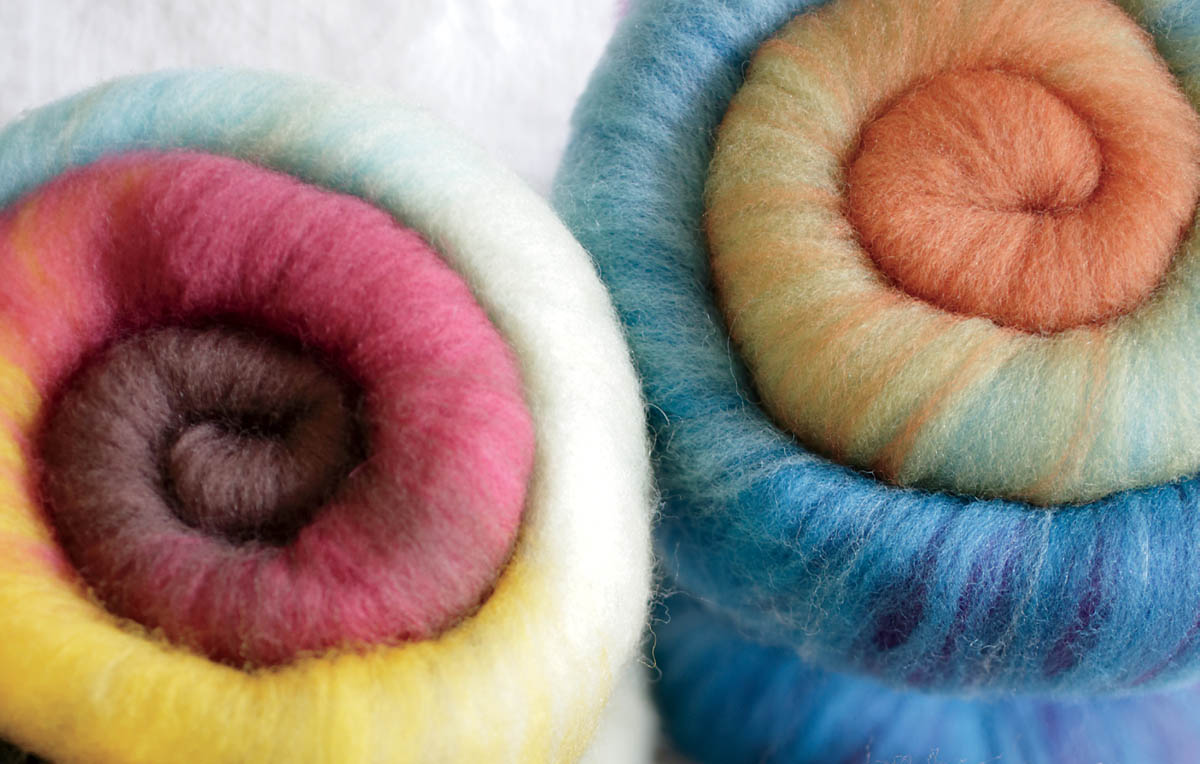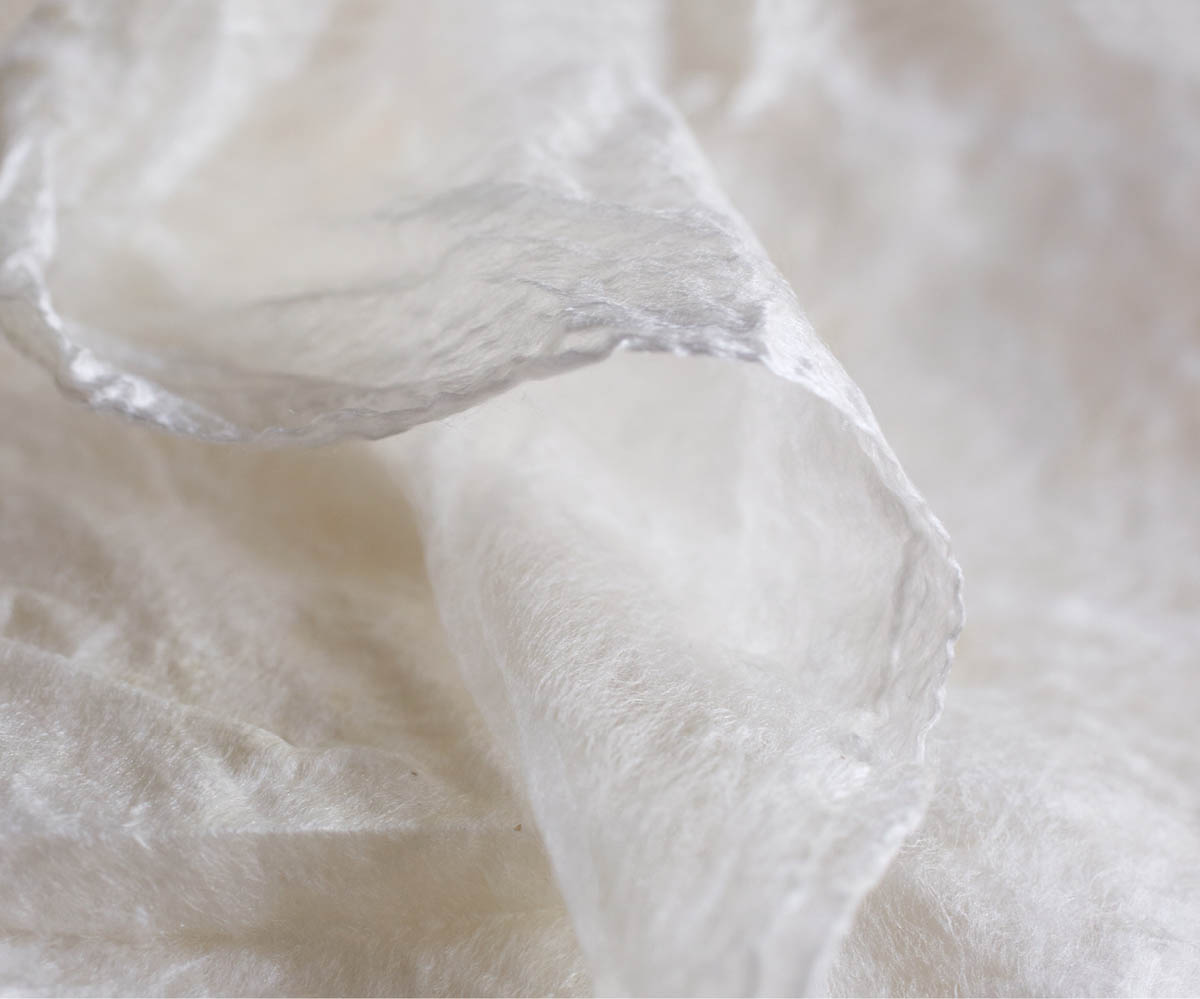
Rolags and a batt made from the braid at the top
Now that we have dipped into types of fiber, what kind of preparation do you want to spin? How fibers are aligned in one of those braided lengths you purchase has an influence on yarn and knitting. Are the fibers aligned straight and smooth, or are they fluffy and going every which way?
Is the silk you have your eye on a handkerchief (“hankies”; see here) or roving? What exactly is “cloud”? Many commercially prepared fibers, most of them gorgeously handdyed, are available for spinners. Some spinners are disinclined to spin anything that they haven’t prepared themselves, and other spinners don’t really want to take the time to hand-prepare fiber and are happy with the commercially prepared fiber that is available. I fall into the latter camp. I can hand-prepare my fibers, and sometimes I do, but there is so much lovely commercially prepared and handdyed fiber around that I almost always reach for that when I spin.
I feel that I have to interject a bit about the glory of hand-prepared fiber. There is nothing like spinning hand-prepared fiber: it is the ultimate in spinning; nothing drafts like it. But for me, it’s also a luxury. I often don’t like to take the time to hand-prepare my fiber, and I like the variety in fiber, fiber blends, and color that commercially prepared fibers bring me.
It’s not the washing of the fleece that stops me. Even if someone handed me a clean fleece to prepare, I still wouldn’t be inclined to do so most of the time. There are days that combing a little and spinning a little is the perfect thing — exactly what I want to do — but right now it’s not my thing, though I do admit the fiber is amazing.
Woolen and worsted are both types of fiber preparations as well as types of drafting styles, which can make talking about them confusing. In “ye olde times” of spinning, woolen preparations were spun with a woolen draft, and worsted preparations were spun with a worsted draft. That is no longer the case. Spinners freely spin any preparation with any draft they choose. The key is to know what type of yarn you’ll get from each type of preparation-and-spin combo. When you throw in the semi phrases (semi-worsted and semi-woolen), the confuse-o-meter goes up another notch.
At their most basic, all preparations begin with fibers that are neither uniform nor varied: it’s the way that they are prepped that makes them either woolen or worsted:
Worsted preparation spun worsted and woolen preparation spun woolen emphasize the characteristics of the preparation. Woolen and worsted preparations spun using the opposite technique create a lovely mixture of both. (For information about spinning worsted and spinning woolen, see chapter 4.)
You can find all of the following types of fiber preparation in commercial fibers. I’ve split them into worsted and woolen preparations and given silk its own category.
A worsted preparation results in top, the most commonly available commercially prepared fiber. You’ll find it in wools, wool blends, alpaca, rayon, Tencel, yak, camel, angora, and silk. In fact, many fibers and fiber blends are combed into top. Here are some characteristics of commercial top:

Braided top (worsted preparation)
You will find several different types of woolen preparations, including roving and its subcategories sliver, pin roving, and pencil roving. (Other woolen preparations include batts, rolags, puni, and clouds, described below. Roving is the most common commercial woolen spinning preparation. Commercial roving is made on carding machines that process fiber like a giant handcard or brush. The fibers in roving are disorganized, going in lots of different directions rather than lying parallel. Roving looks puffier than top, with a matte and uneven surface. When roving comes off the machine, a slight twist is put into it. Roving that is spun with a woolen draft makes yarn that is warm and light. Roving spun with a worsted draft is more compressed, not as light, but more durable over time.

Fiber preparations from left to right: Sliver, top (a worsted prep), roving, and pencil roving
Batts are giant sheets of carded fiber. They can be made on a commercial carding machine or a drum carder. Batts are frequently blends of fiber and run the gamut from mild and smooth to wild and chunky. Batts, especially fresh batts, are amazingly airy and can be spun in two directions: if spun with the grain of the batt (the direction it was carded in), the yarn is lofty; if spun against the grain, the yarn becomes super lofty.
Spinning a batt with a woolen draft emphasizes the loft. The yarn is spongy and light, but it can be quite delicate. Spinning a batt with a worsted draft removes the signature air, creating a more compact yarn. Smooth batts made of slick, lustrous fibers are lovely spun worsted, as that method brings out the most shine possible in the fiber. Spinning a chunky, wild batt with a worsted draft, however, can be an exercise in frustration. This is a batt that won’t make a smooth yarn.

Batts, which are large sheets of carded fiber, offer many options for spinners.
Rolags are made with handcards or a blending board, and then rolled loosely into a tube. They spin like smaller versions of batts. Rolags made on handcards frequently contain only one fiber, or perhaps a blend of two or three fibers. Rolags made on blending boards rival art batts for their variety of content and color. (See photograph of an art batt.)
Fauxlags are made from portions of batts, top, or roving wound into a tube around a dowel, knitting needle, chopstick, or ruler. They are usually not as lofty as rolags.
A puni is a smaller version of a rolag, rolled tightly when taken off handcards or a blending board. These are often used for cotton and other short-stapled fibers.

Rolags and punis, which are loosely rolled tubes made from carded fiber, spin much like batts.
A cloud is an airy handful of fiber, usually pygora, cashmere, camel, or yak. After the coarse fibers have been removed (dehaired) and what remains has been washed, it is left as a mass of fiber that looks a lot like a cloud. The fiber is not directional, so it is simply spun from the little nest of fiber. Cloud spun woolen preserves the airiness in the preparation and the downy fibers; cloud spun worsted makes a more durable, less lofty yarn.
The fiber of longwool sheep is washed and frequently dyed without further preparation, or it may be added to wild batts and spun into textured and art yarns. These locks are gorgeous and very textural.
Silk seems to come in the biggest variety of preparations. While it is available as top and roving, here is a quick look at some other preparations you might find when fiber shopping.

Sari silk can be a colorful addition when blended with other fibers.

One silk preparation that is easy to spin is known as a hanky.